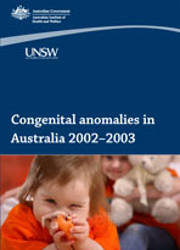Summary
Congenital anomalies are rare conditions which often result in long-term morbidity or death. Most babies who survive with major congenital anomalies need specialist medical care, surgical intervention, intensive care management, long-term hospitalisation and rehabilitation which involve a considerable amount of resources. This second report on congenital anomalies in Australia presents epidemiological data on 33 selected conditions because they are monitored internationally by the International Clearinghouse of Birth Defects Surveillance and Research.
Most common congenital anomalies
Hypospadias is the most commonly reported condition at birth, but severity of the condition is not reported to the national data collection. Trisomy 21 (Down’s syndrome) is the next most commonly reported condition at birth (11.1 per 10,000 births), but many affected pregnancies are detected early and managed by early termination. An estimated 63.6% of the fetuses diagnosed with trisomy 21 were managed by terminations of pregnancy or were fetal deaths. When terminations of pregnancy were included, the estimated rate for trisomy 21 was 26.3 per 10,000 pregnancies. Trisomy 21 was more common with advancing maternal age. Other chromosomal abnormalities such as trisomy 13 and trisomy 18 also had a large proportion of fetal deaths or terminations of pregnancy and were more common in women aged 40 years or older.
Neural tube defects
Neural tube defects were diagnosed in about 4.2 per 10,000 births. The estimated rate based on information from the four states collecting the terminations of pregnancy data shows that the prevalence of neural tube defects was 9.8 per 10,000 pregnancies in 2002–2003. However, the 2002–2003 rate was lower than the rate reported for the period 1998–2001. About 76% of the pregnancies affected with neural tube defects were managed by early terminations of pregnancy or were fetal deaths. Information from the Australian Congenital Anomalies Monitoring System (ACAMS) will be used to provide a baseline prevalence of neural tube defects in Australia prior to the introduction of mandatory fortification of bread flour with folic acid. This public health initiative is aimed at preventing neural tube defects and data from ACAMS will be used in the future evaluation of the initiative.
Indigenous mothers and their babies
A higher rate of congenital anomalies was reported for the births of Indigenous women compared to non-Indigenous women (356 per 10,000 births versus 308 per 10,000 births). Nearly 72% of the Indigenous women whose pregnancies were affected with a congenital anomaly were aged less than 30 years whereas only 43% of the non-Indigenous women with affected pregnancies were less than 30 years of age. It is hoped in future reports that data will be available from the Northern Territory where an approximately three in ten births are to Indigenous women.
More males than females diagnosed with congenital anomalies
The proportion of males diagnosed with a reported congenital anomaly was higher than the proportion of females for many of the reported conditions (e.g. hydrocephalus, most of the reported congenital heart diseases, oesophageal atresia and polycystic kidneys).
The need for more information
A program of national data development is underway to develop a national minimum data set on congenital anomalies. In conjunction with this is the development of a set of clinical definitions by the Australian Paediatric Surveillance Unit. Both these initiatives will improve the quality of national information on congenital anomalies. Further data development is needed on the jurisdictional coverage and quality of termination of pregnancy data to support national reporting of congenital anomalies. Anomalies causing severe disabilities are more likely to be managed by terminations of pregnancy or end in fetal deaths (e.g. neural tube defects, Down’s syndrome) whereas surgically correctable conditions (e.g. many cardio vascular anomalies) and the conditions that do not cause major disability are unlikely to lead to termination of pregnancy. Only four states collect and provide data on terminations of pregnancy at less than 20 weeks with diagnosis of congenital anomalies. Further to this, only South Australia and Western Australia have mandatory notification of termination of pregnancy irrespective of gestational age. National consistency in the data collection of terminations of pregnancy will more accurately report the burden of congenital anomalies in Australia. This will result in more accurate information for use in policy development and the planning of services for the prevention and management of congenital anomalies in Australia.
Preliminary material: Acknowledgments; Acronyms and abbreviations; Symbols
Introduction
- Background
- Aims of the Australian Congenital Anomalies Monitoring System (ACAMS)
Data sources and methods
Selected congenital anomalies
- Introduction
- Anencephaly
- Spina bifida
- Encephalocele
- Neural tube defects
- Microcephaly
- Arhinencephaly/ Holoprosencephaly
- Hydrocephaly
- Anophthalmos/ Microphthalmos
- Microtia
- Transposition of great vessels
- Tetralogy of Fallot
- Hypoplastic left heart syndrome
- Coarctation of the aorta
- Choanal atresia
- Cleft palate without cleft lip
- Cleft lip with or without cleft palate
- Oesophageal atresia/stenosis
- Small intestinal atresia/stenosis
- Anorectal atresia/stenosis
- Hirschsprung’s disease
- Hypospadias
- Epispadias
- Renal agenesis/dysgenesis
- Cystic kidney
- Bladder exstrophy
- Polydactyly
- Limb reduction defects
- Diaphragmatic hernia
- Exomphalos
- Gastroschisis
- Trisomy 13
- Trisomy 18
- Trisomy 21
Future directions
- National Minimum Data Set for congenital anomalies
- Clinical definitions
- National report on neural tube defects
- Newborn screening
Appendix
Appendix A: Denominator data
Appendix B: State and territory reports on congenital anomalies
Appendix C: Data collection contacts for congenital anomalies
Appendix D: National Congenital Anomalies Steering Committee, State and Territory Implementation Committee for Congenital Anomalies
End matter: Glossary; References; List of Tables; List of Figures



